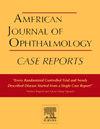视网膜大动脉瘤黄斑渗出灶性光凝治疗难治性的手术治疗2例
Q3 Medicine
引用次数: 0
摘要
目的报告2例视网膜动脉大动脉瘤(MaAs)致黄斑渗出的难治性光凝治疗,采用新的手术技术,包括注射视网膜下平衡生理盐水(BSS)稀释富含脂质的视网膜下液(SRF),促进SRF的吸收,形成视网膜孔,引导SRF进入玻璃体腔。在maa后部进行激光光凝,以防止视网膜内液和SRF到达中央窝。观察我院收治1例70岁男性黄斑水肿(ME)患者,抗血管内皮生长因子(VEGF)治疗无效。眼底检查显示视网膜动脉MaAs及硬渗出。他接受了激光光凝、曲安奈德(STTA)亚腱注射和抗vegf治疗;尽管进行了所有治疗,但ME还是复发了。视网膜动脉MaAs的视网膜下富含脂质的渗出物累及黄斑,导致严重的视力丧失。因此,计划采用新技术进行玻璃体切除术,以冲洗富含脂质的SRF,并防止新的渗出物到达黄斑。术后,SRF完全消退,ME直到术后59个月才复发。第二例患者为77岁女性,患有视网膜前膜和ME伴结节病。她接受了抗vegf治疗、STTA注射和局部激光光凝治疗。威胁视力的ME持续存在。采用新技术行玻璃体切除术,黄斑渗出迅速消失。术后27个月未复发。结论对于视网膜MaAs对多种常规治疗方法均有抵抗而危及视力的ME患者,可考虑玻璃体切除术。本文章由计算机程序翻译,如有差异,请以英文原文为准。
Surgical management of two cases with macular exudation from retinal macroaneurysms refractory to focal photocoagulation
Purpose
To report two cases of macular exudations resulting from retinal arterial macroaneurysms (MaAs) refractory to focal photocoagulations that were treated with a new surgical technique including subretinal balanced saline solution (BSS) injection to dilute lipid-rich subretinal fluid (SRF) and facilitate absorption of the SRF, intentional retinal hole formation to direct SRF into the vitreous cavity, and laser photocoagulation posterior to the MaAs to prevent intraretinal fluid and SRF from reaching the fovea.
Observations
A 70-year-old man with macular edema (ME) refractory to anti-vascular endothelial growth factor (VEGF) therapy was referred to our hospital. Fundus examination showed retinal arterial MaAs and hard exudations. He underwent laser photocoagulation, sub-Tenon injections of triamcinolone acetonide (STTA), and anti-VEGF therapies; the ME recured despite all treatments. Subretinal lipid-rich exudatoins from retinal arterial MaAs involved the macula, which led to severe vision loss. Therefore, vitrectomy with the new technique was planned to flush out the lipid-rich SRF and prevent new exudations from reaching the macula. Postoperatively, the SRF resolved completely and the ME has not reccured until 59 months postoperatively at his latest visit. The second patient was a 77-year-old woman with an epiretinal membrane and ME with sarcoidosis. She underwent anti-VEGF therapy, STTA injection, and focal laser photocoagulation. The vision-threatening ME persisted. She underwent vitrectomy with the new technique, and the macular exudation resolved promptly. The ME has not recurred 27 months postoperatively.
Conclusions
Vitrectomy with this technique may be considered in cases with vision-threatening ME due to retinal MaAs resistant to combined multiple conventional treatments.
求助全文
通过发布文献求助,成功后即可免费获取论文全文。
去求助
来源期刊

American Journal of Ophthalmology Case Reports
Medicine-Ophthalmology
CiteScore
2.40
自引率
0.00%
发文量
513
审稿时长
16 weeks
期刊介绍:
The American Journal of Ophthalmology Case Reports is a peer-reviewed, scientific publication that welcomes the submission of original, previously unpublished case report manuscripts directed to ophthalmologists and visual science specialists. The cases shall be challenging and stimulating but shall also be presented in an educational format to engage the readers as if they are working alongside with the caring clinician scientists to manage the patients. Submissions shall be clear, concise, and well-documented reports. Brief reports and case series submissions on specific themes are also very welcome.
 求助内容:
求助内容: 应助结果提醒方式:
应助结果提醒方式:


